New Energy
Annual Production of 4 GW·h Battery System Production Line Project of Baicheng City
1 Introduction to the Project
1.1 Project background
1.1.1 Product introduction
Electric energy storage system is a system that converts electrical energy into other forms of energy for storage, so that it can be converted into electrical energy and supplied to the power grid or electrical equipment when needed. The power storage system can "splice" intermittent renewable energy sources together, improve the stability of the power system, and thus solve the bottleneck problem of renewable energy development.
The power energy storage system mainly includes various types such as battery energy storage system, super capacitor energy storage system, compressed air energy storage system, gravity energy storage system, etc. Each energy storage system has its unique advantages and application scenarios.
The application scope of electric energy storage systems is wide, including the integration of renewable energy, grid regulation, power load management, emergency power supply, and many other aspects. By reasonably configuring and using power storage systems, the flexibility, reliability, and economy of the power grid can be effectively improved, promoting the sustainable development of the power system.
The project utilizes the abundant wind and photovoltaic resources in Baicheng City to construct a production line with an annual output of 4 GW·h battery system. The construction of the project can further improve the utilization rate of renewable energy and promote the development of the new energy industry in Baicheng City.
1.1.2 Market prospect
(1) Application scenarios of new energy storage
Energy storage technology is a key technology for solving large-scale storage and scheduling of electricity, and plays an important role in maintaining the stability and flexibility of the power system. With the continuous increase in the scale of wind and photovoltaic power generation connected to the grid, the power system is facing significant fluctuations. Energy storage technology plays a role in balancing supply and demand on the power generation side, grid side, and user side, greatly improving the reliability of wind and photovoltaic power generation.
From the perspective of the entire power system, the application scenarios of new energy storage can be divided into three major scenarios: Generation side energy storage, transmission and distribution side energy storage, and user side energy storage; On the power generation side, the main application scenarios of new energy storage are secondary frequency regulation and renewable energy distribution and storage; On the transmission and distribution side, the main application scenarios are to alleviate transmission and distribution congestion, delay the expansion of distribution equipment, power supply and peak shaving, primary frequency regulation, etc; On the user side, the main application scenarios are peak shaving, capacity cost management, improving power quality, and enhancing power supply reliability.
(2) The technological roadmap for new energy storage
New energy storage refers to energy storage technologies other than pumped storage. Energy storage forms are mainly divided into three categories based on different technological paths: Thermal energy storage, electrical energy storage, and hydrogen energy storage. Among them, electrical energy storage can be further divided into physical energy storage, electromagnetic energy storage, and electrochemical energy storage according to energy storage forms. In addition to pumped storage, physical energy storage also includes compressed air energy storage, flywheel energy storage, gravity energy storage, etc. Electromagnetic energy storage includes superconducting energy storage, super capacitor energy storage, etc; Electrochemical energy storage includes forms of energy storage such as lithium-ion batteries, sodium batteries, lead-acid batteries, flow batteries, sodium sulfur batteries, fuel cells, etc; Thermal energy storage mainly includes molten salt energy storage, hot and cold energy storage, etc.
Electrochemical energy storage accounts for 97% of the cumulative installed capacity in the new energy storage system, occupying a dominant position.
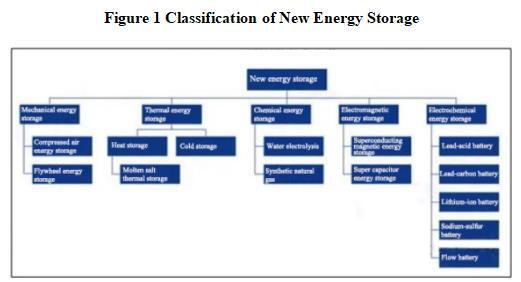
(3) New energy storage industry chain
From the perspective of industrial chain links, the upstream of the new energy storage industry chain includes various hardware equipment and software systems; The midstream of the new energy storage industry chain is a provider of energy storage system software and hardware, as well as energy storage solution providers. Energy storage solutions are usually composed of energy storage system integration products and energy storage system software products. In addition, the installation, construction, operation, and maintenance of energy storage solutions are also very important links; The downstream application scenarios include power stations on the generation side, power grid companies on the grid side, and industrial and commercial energy storage user scenarios. Energy storage system is a comprehensive energy control system with batteries as the core, which mainly includes energy storage batteries, PCS, BMS, EMS, and other components. The cost of energy storage batteries accounts for approximately 55% of the total cost of the energy storage system; PCS, BMS, EMS (abbreviated as 3S) account for about 35% and play a crucial role in energy storage systems; Other components include temperature control systems, wires and cables, containers, distribution cabinets, etc.
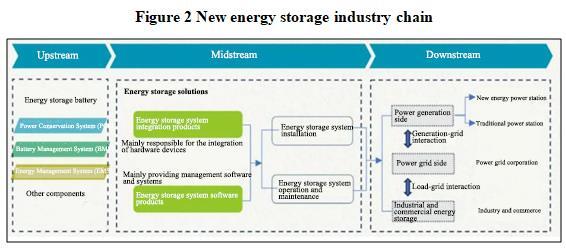
(4) Market scale of new energy storage industry
According to the White Paper on Energy Storage Industry Research 2024, the cumulative installed capacity of global energy storage will reach 289.2GW in 2023, of which pumped storage accounts for 67.0% and new energy storage accounts for 31.6%. As the world's largest new energy storage market, China will add 21.5GW/46.6GW·h of new energy storage installed capacity in 2023, with a year-on-year growth of over 150% in both power and energy scale.
As of the end of October 2024, the cumulative installed capacity of China's new energy storage market in 2024 was 23.42GW/58.86GW·h, a year-on-year increase of 118% (based on energy scale). The scale of project operation doubled compared to the same period last year. With the considerable overall growth rate, the industry continues to improve and gradually mature. In October 2024, the newly installed capacity of new energy storage was 2.04GW/5.50GW·h, an increase of 82% month on month (based on energy scale), while the scale still increased by 236% compared to the same period last year (based on energy scale).
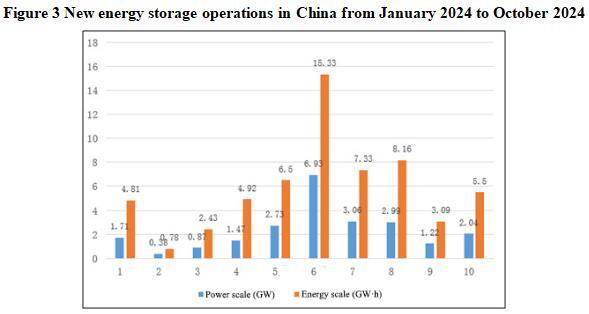
From the perspective of new energy storage application scenarios, the proportion of energy storage on the grid side is the highest (69%), thanks to policy promotion and mature business models. Independent energy storage will dominate the overall power station operation in 2024; Energy storage on the power side ranks second (25%), with photovoltaic distribution and storage accounting for the highest proportion; The proportion of user side energy storage is the lowest (6%), mainly consisting of industrial and commercial energy storage. In addition, with the gradual growth of the industrial and commercial energy storage market, the prosperity of emerging application scenarios such as photovoltaic charging and user side micro-grids has significantly increased, and it is expected to become a new increment in 2024-2025.
(5) Current development of electrochemical energy storage
At present, pumped storage is still the largest installed energy storage technology. Among the new energy storage technologies, electrochemical energy storage has developed the most rapidly, showing a synchronous development of various technological routes such as lithium-ion batteries, flow batteries, sodium-ion batteries, and solid-state batteries.
Electrochemical energy storage is the process of converting chemical energy and electrical energy through chemical reactions to store energy. Depending on the material, it can be mainly divided into lead-acid batteries, sodium sulfur batteries, flow batteries, and lithium-ion batteries. On the one hand, battery energy storage has a high energy density and conversion efficiency, and a fast response speed, which can effectively meet the peak shaving and frequency regulation needs of the power system; On the other hand, its power and energy can be flexibly configured according to different application requirements, almost unaffected by external climate and geographical factors.
By the end of 2023, a total of 1375 electrochemical energy storage power stations with a total power of 45.43GW and a total energy of 92.61GW·h have been submitted by 19 member units of the National Electric Power Safety Commission. Among them, 958 power stations have been put into operation with a total power of 25.00GW and a total energy of 50.86GW·h (863 in operation with a total power of 24.35GW and a total energy of 49.62GW·h, 95 out of service with a total power of 0.65GW and a total energy of 1.25GW·h), and 417 power stations under construction with a total power of 20.43GW and a total energy of 41.75GW·h. In 2023, 486 new electrochemical energy storage power stations will be put into operation, with a total power of 18.11GW and a total energy of 36.81GW·h, exceeding the total cumulative installed capacity of previous years.
As of the end of 2023, the installed capacity of electrochemical energy storage that has been put into operation is equivalent to 0.86% of the total installed capacity of power sources in China and 2.24% of the total installed capacity of new energy. Among them, the newly installed electrochemical energy storage capacity put into operation in 2023 is equivalent to 4.91% of the newly installed power supply capacity in China and 6.08% of the newly installed new energy capacity.
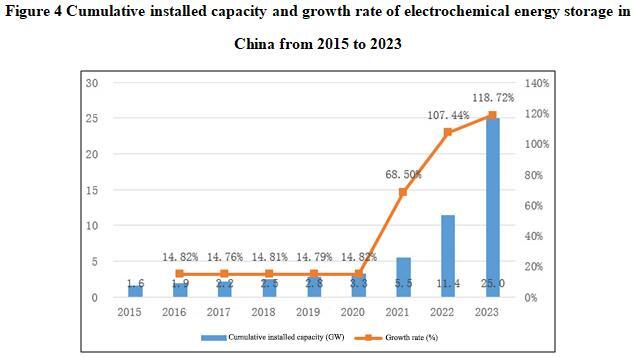
The popularization of energy storage products will promote the efficient utilization of green energy and become one of the important influencing factors of global energy transformation. Energy storage is an important means to enhance the flexibility, economy, and safety of traditional power systems, and is also a key technology to promote the replacement of fossil energy with renewable energy as the main energy source.
According to the International Renewable Energy Agency (IRENA), in order to achieve emission reduction targets, the proportion of electricity in terminal energy consumption needs to increase from less than 20% currently to nearly 50% by 2050. In developed overseas regions, renewable energy sources such as photovoltaics and wind power have begun to replace existing thermal power installations in the electricity installation structure. In the future, with the acceleration of clean electricity under the background of Carbon Peaking and Carbon Neutrality Goals, the demand for energy storage will continue to grow, the implementation of policies in the energy storage field at home and abroad will increase, and factors such as the decrease in lithium battery costs and the improvement of cycle life will be combined. The energy storage market will usher in a rapid development stage with broad prospects.
1.1.3 Technical analysis
Energy storage technology refers to the use of chemical or physical methods to store electrical energy generated from primary energy and release it when needed, including input and output of energy and materials, energy conversion and storage devices. Battery Energy Storage System (BESS) is a system that uses lithium/lead batteries as energy storage carriers to store and supply electrical energy for a certain period of time. It has functions such as smooth transition, peak shaving, frequency and voltage regulation. The energy storage system mainly consists of energy storage units and monitoring and scheduling management units: The energy storage units include energy storage Battery Packs (BA), Battery Management Systems (BMS), Power Conservation Systems (PCS), etc; The monitoring and scheduling management unit includes Micro Grid Control Center (MGCC), Energy Management System (EMS), etc.
The energy storage technology has become relatively mature. The project introduces enterprises with advanced production technology and forms synergy with local energy storage enterprises to continuously innovate production technology in the production process.
1.1.4 Advantageous conditions of project construction
(1) Policy advantageous
In July 2021, the National Development and Reform Commission (NDRC) and the National Energy Administration (NEA) jointly issued the Guiding Opinions on Accelerating the Development of New Energy Storage (NDRC-NEA [2021] No. 1051), aiming to promote the innovation and application of energy storage technologies through policy support and market mechanisms. The document outlined the goal of transitioning new energy storage from the initial commercialization phase to large-scale development by 2025, with significantly enhanced technological innovation capabilities and an installed capacity of over 30 million kilowatts. By 2030, new energy storage is expected to achieve full market-oriented development, becoming a key pillar for carbon peaking and carbon neutrality in the energy sector.
In October 2021, the State Council released the Carbon Peaking Action Plan Before 2030, proposing the active development of "new energy + energy storage," Generation-Grid-Load-Storage Integration System, and Multi-Energy Integration System. It also supports the rational deployment of energy storage systems for distributed new energy.
In February 2022, the NDRC and the NEA jointly issued the Implementation Plan for the Development of New Energy Storage During the 14th Five-Year Plan Period (NDRC-NEA [2022] No. 209), aiming to advance the development of new energy storage technologies and support the transformation of the energy structure. The plan includes overall requirements, six key tasks, and safeguard measures. The six key tasks focus on technological innovation, pilot demonstrations, scale development, institutional mechanisms, policy support, and international cooperation, outlining the priorities for new energy storage development during the 14th Five-Year Plan period.
In June 2022, the NDRC and the NEA jointly issued the Notice on Further Promoting the Participation of New Energy Storage in the Power Market and Dispatch Applications (NDRC [2022] No. 475), aiming to clarify the market positioning of new energy storage, establish and improve relevant market mechanisms, pricing mechanisms, and operational mechanisms, enhance the utilization level of new energy storage, and guide the healthy development of the industry.
In June 2022, the NDRC, the NEA, and other departments released the 14th Five-Year Plan for Renewable Energy Development, which affirmed the independent market entity status of new energy storage and improved the trading mechanisms and technical standards for energy storage participation in various power markets.
(2) Resource advantageous
The total area of jurisdiction in Zhenlai County is 4718.69 square kilometers. Zhenlai County has a total of 187300 hectares of arable land, 404.19 hectares of garden land, 40300 hectares of forest land, 41100 hectares of grassland, 13800 hectares of urban and industrial land, 9563.47 hectares of transportation land, 95200 hectares of water bodies and water conservancy facilities, and 84200 hectares of other land. Zhenlai County has adequate industrial and construction land.
Zhenlai County has abundant power resources, with a clean energy development area of 600 square kilometers. The total installed capacity of thermal power and clean energy within a radius of 100 kilometers is 3 GW, with a full load power generation of 16 TW·h. The total electricity consumption of the society is 5 TW·h, and the annual surplus electricity is 11 TW·h. It is one of the first batch of clean energy demonstration cities and wind power local consumption demonstration areas in China.
(3) Industrial advantageous
Relying on the existing resources and national policies, Zhenlai County focus on introducing comprehensive development of wind and solar energy, as well as supporting equipment and component production projects. Efforts have been made to introduce high load industrial projects with advanced technology, high energy utilization efficiency, high energy consumption and environmental protection. The main wind power enterprises in Zhenlai County include Zhenlai Wind Power Plant of Huaneng Jilin Power Generation Co., Ltd. and Zhenlai Huaxing Wind Power Generation Co., Ltd.
(4) Location advantageous
Zhenlai County is located at the junction of the three major resource provinces (regions) of Heilongjiang, Jilin, and Inner Mongolia, and is known as the "where the rooster crows can be heard in three provinces". Within a radius of 200 kilometers, it is surrounded by five prefecture level cities (Songyuan City, Baicheng City, Qiqihar City, Daqing City, Ulanhot City) and five regional airports, and is only 40 kilometers away from Baicheng Airport. There are two railways and two highways intersecting within the territory, making it an important "hub type" city at the junction of Heilongjiang Province, Jilin Province, and Inner Mongolia Autonomous Region. It is a must pass place for Inner Mongolia and Heilongjiang to enter the Shanhai Pass, with convenient transportation and developed logistics, and has strong advantages in radiation and driving.
(5) Talent advantageous
There are several research institutes in Baicheng City, including the Academy of Agricultural Sciences, the Academy of Forestry Sciences, the Agricultural Machinery Research Institute, the Livestock Research Institute, and the Research Institute. There are 40873 professional and technical personnel, including 6898 with senior professional titles, 18409 with intermediate professional titles, and 15566 with junior professional titles.
In 2023, Baicheng City issued the 20 Measures on Strengthening and Improving the City's Talent Work, based on regional advantages, maximizing the utilization of local talent resources, accelerating the construction of three teams of expert strategic talents, practical local talents, and technical blue collar talents, and providing strong talent guarantee for the comprehensive construction of a socialist modernized new Baicheng City.
1.2 Contents and scale of project construction
1.2.1 Product scale
The overall project plan is to construct a 4 GW·h battery system production line, which will be built in three phases. The Phase Ⅰ involves the construction of a 1 GW·h battery system production line, including the production of civilian vehicle battery systems, communication energy storage systems, and large-scale power energy storage systems; The Phase II plans to construct a 1 GW·h battery system production line, including the construction of lithium-ion and sodium-ion battery cell production lines; The Phase III plans to construct a 2 GW·h battery system production line, including the construction of home energy storage systems, industrial and commercial energy storage system projects, engineering mining battery systems, and the expansion of large-scale power energy storage system production lines.
1.2.2 Contents of project construction
The project covers a total area of 100000 square meters and has a total construction area of 100000 square meters. The Phase Ⅰ of the project covers an area of 20000 square meters and has a building area of 20000 square meters; The Phase II of the project covers an area of 30000 square meters and has a building area of 30000 square meters; The Phase III of the project covers an area of 50000 square meters and has a building area of 50000 square meters. The project mainly involves the construction of production workshops, research and development centers, quality inspection workshops, warehouses, office buildings and other buildings, the purchase of production equipment, and the construction of supporting facilities such as water, electricity, heating, ground hardening, and greening.
1.3 Total investment of the project and capital raising
1.3.1 Total investment of the project
The total investment of the project is 850 million yuan, including a construction investment of 800 million yuan and a working capital of 50 million yuan.

1.3.2 Fundraising
Fundraised independently by the enterprise.
1.4 Financial analysis and social evaluation
1.4.1 Main financial indexes
After the project reaches the production capacity, its annual sales income will be 2.4 billion yuan, its profit will be 260 million yuan, its investment payback period will be 6.3 years (after the tax, including the construction period of 3 years) and its investment profit rate will be 30.6%.
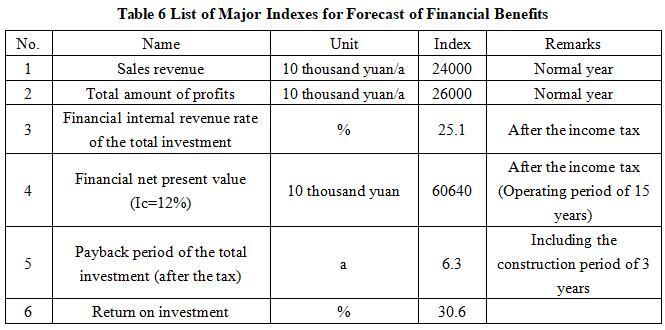
Note: “10 thousand yuan” in the table is in RMB.
1.4.2 Social evaluation
The combination of energy storage systems and renewable energy can further improve the utilization rate of renewable energy, reduce dependence on traditional energy, reduce carbon emissions and energy consumption, and promote the development of a low-carbon economy. The construction of energy storage systems helps to reduce economic losses caused by power outages, improve the stability of the power system, and increase the production and living security of enterprises and individuals. The construction of the project has significant economic and social benefits.
1.5 Cooperative way
Sole proprietorship, joint venture.
1.6 What to be invested by the foreign party
Funds, equipment and technology
1.7 Construction site of the project
Zhenlai County, Baicheng City.
1.8 Progress of the project
The project proposal has been prepared.
2 Introduction to the Partner
2.1 Basic information
Name: Zhenlai County Project Development Service Center
Address: No.1777 Xinxing South Street, Zhenlai Town, Zhenlai County, Baicheng City
2.2 Overview
Zhenlai County is located in the northwest of Jilin Province, at the junction of Jilin, Heilongjiang, and Inner Mongolia provinces (regions), and is a convergence zone of the Songnen Plain and the Horqin Grassland. To the east is the Nenjiang River, facing Dorbod Mongol Autonomous County and Zhaoyuan County in Heilongjiang Province across the river, to the west is Ulanhot City in Inner Mongolia Autonomous Region, to the north is Tailai County in Heilongjiang Province and Zhalaite Banner in Inner Mongolia Autonomous Region, and to the southwest and south are adjacent to Baicheng City, Da'an City, and Taobei District respectively. Zhenlai County is a large-scale commodity grain base and livestock development demonstration base in China. Zhenlai County has obvious advantages in location and transportation. With Zhenlai County as the center and a radius of 500 kilometers, it can comprehensively cover industrial cities and resource rich areas in the northeast region.
In 2023, Zhenlai County's GDP reached 9.48 billion yuan, a year-on-year increase of 6.6%; The fixed assets investment reached 2 billion yuan, up 23.6% year on year; The total output value of industrial enterprises above designated size reached 2.7 billion yuan, a year-on-year increase of 9%; The added value of industrial enterprises above designated size reached 780 million yuan, a year-on-year increase of 7%; The total retail sales of consumer goods reached 1.42 billion yuan, a year-on-year increase of 7%; The local level fiscal revenue reached 400 million yuan, a year-on-year increase of 20%; The per capita disposable income of urban residents increased by 8% year-on-year; The per capita disposable income of rural residents increased by 9% year-on-year.
2.3 Contact method
2.3.1 Contact method of cooperator
Contact unit: Zhenlai County Project Development Service Center
Contact person: Tian Tian
Tel: +86-15886168765
2.3.2 Contact person of the city (prefecture) where the project is located:
Contact unit: Baicheng Municipal Bureau of Commerce
Contact person: Xu Zengchun
Tel: +86-436-3203010
+86-13894682986
E-mail: bcjhj07@126.com


